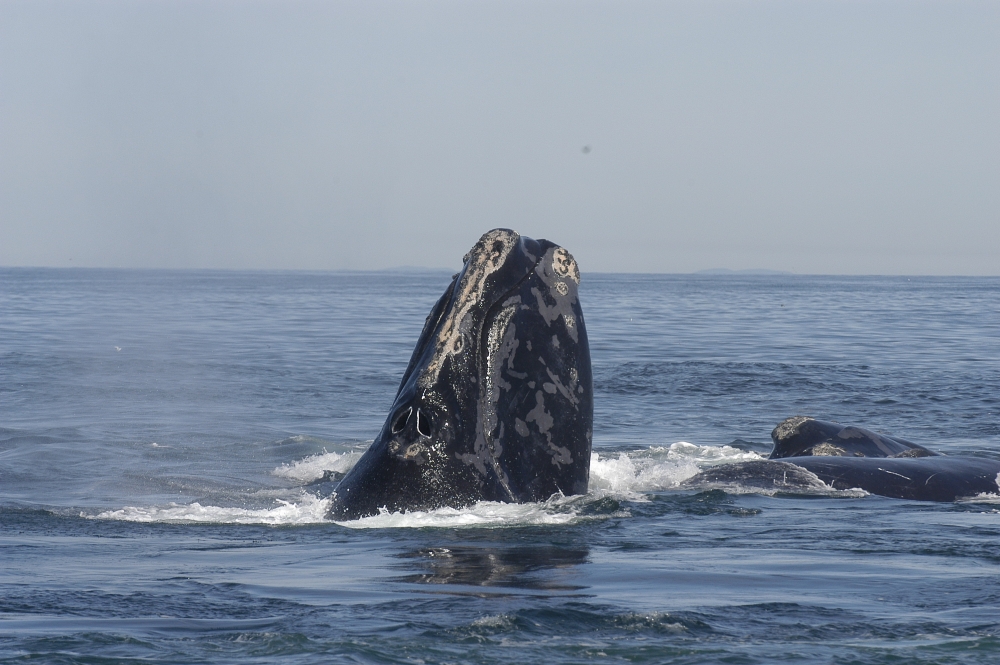
Doing Right by the Whales

These are not good times for the North Atlantic right whale. Ship strikes and gear entanglement play major roles in the mortality of these highly endangered mammals, which now number fewer than 500. Making matters worse, climate-mediated shifts are pushing their prey out of the whales’ usual feeding grounds, rendering traditional habitat-focused protection policies less than optimal.
This reality was starkly apparent in the summer of 2017, when 17 right whales turned up dead in U.S.-Canadian waters — a mass mortality event attributed in large part to gear entanglement and ship strikes. The event also revealed that the whales had gone beyond their typical distributional boundaries. Scientists estimate that unless protective policies are expanded to cover their shifting distribution, right whales may face extinction in less than 30 years.
That’s according to a new study by researchers including UC Santa Barbara Marine Science Institute ecologist Erin Meyer-Gutbrod. With atmospheric scientist Charles H. Greene, of Cornell University, and postdoctoral research associate Kimberley T. A. Davies, of Dalhousie University, Meyer-Gutbrod authored the paper “Marine Species Range Shifts Necessitate Advanced Policy Planning,” which appears in the journal Oceanography.
According to the group’s findings, “only five calves were born in 2017 and no newborn calves have been sighted thus far in 2018.”
“What we have seen with prey limitation is that whales will search outside of their traditional feeding grounds, looking for denser aggregations of zooplankton,” said Meyer-Gutbrod, who studies the effects of environmental change on right whale populations. Due to the northward movement of their food from their usual Gulf of Maine feeding grounds to the Gulf of St. Lawrence in Canadian waters, the whales, too, are shifting away from their usual habitats and into unprotected regions. The combination of food scarcity in their usual habitat and lack of protection in their adopted feeding grounds, Meyer-Gutbrod and colleagues say, calls for advanced policy planning that essentially follows these whales as they stake out new territory.
“Prey limitation is not typically so severe that right whales starve to death,” said Meyer-Gutbrod. However, she explained, when prey is scarce, adult females don’t have enough energy to reproduce successfully. In addition, when the whales move from their typical protected waters into heavily-trafficked and unprotected areas, they encounter a minefield of obstacles, from commercial shipping vessels to crab and lobster fishing gear.
But it may not be too late, the researchers say, if policymakers respond rapidly and advanced strategies are used to mitigate the risk to the whales as their distribution shifts. Such “impressive” response went into play during the Gulf of St. Lawrence crisis, with emergency measures that included a multi-platform search for the whales, mandatory speed limits and crab fishery closures.
In addition to those measures, which are now part of a 2018 protection plan announced by Fisheries and Oceans Canada, the researchers recommend a “robust and sustainable program” for monitoring the whales and reinstitution of a prey monitoring system called the Continuous Plankton Recorder program. Additionally, they recommend ongoing evaluation of the effectiveness of new and existing policies and the potential expansion of critical habitats into the Gulf of St. Lawrence.
North Atlantic right whales are the current target of these proposed enhanced protections, but likely are not the only species that will require such measures, according to Meyer-Gutbrod.
“A massive poleward redistribution of targeted fish stocks is impending,” she said. “Fishing pressure will probably grow rapidly at the leading edge of the range shift, but pressure may also increase near the trailing edge when more effort is required to catch the same number of fish. This puts shifting stocks at risk of being overfished.”



